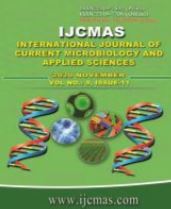


 National Academy of Agricultural Sciences (NAAS)
National Academy of Agricultural Sciences (NAAS)

|
PRINT ISSN : 2319-7692
Online ISSN : 2319-7706 Issues : 12 per year Publisher : Excellent Publishers Email : editorijcmas@gmail.com / submit@ijcmas.com Editor-in-chief: Dr.M.Prakash Index Copernicus ICV 2018: 95.39 NAAS RATING 2020: 5.38 |
Citrus is India's third-largest fruit crop, boosting production of 1.07 million hectares to 10.48 million tonnes (2013-14). Therefore, yields of 20-25 tonnes/ha have been recorded by some progressive growers, but average productivity is 9.78 tonnes/ha. In other countries where citrus is grown, these numbers are 40-50 tonnes, and the production life in orchards is much longer. High-strength cultivation with automatic fertilization has contributed significantly to the commercial citrus cultivation revolution in many countries. Post-harvest illness causes significant losses to fruits and vegetables harvested around the world. In addition to various treatments aimed at controlling post-harvest losses caused by pathogens, global trends are moving towards more environmentally friendly and safer alternatives for human health. To date, the main approach to post-harvest disease control has relied heavily on the use of chemicals. However, widespread use of chemical fungicides has caused side effects such as environmental problems and the development of fungicide-resistant isolates. With the growing demand for the use of non-chemical, ionizing radiation has been investigated for application in many aspects of post-harvest treatment, especially as an approach with great potential for post-harvest disease management. A series of methodologies that have recently made more or less technological advances, such as. Irradiation has been developed that combines other types of treatment with disease-related resistance to control post-harvest disease and improve the quality and shelf life of fresh produce. Future irradiation challenges in fresh foods are cost, lack of irradiation equipment, lack of information on optimal conditions for various crops, and rejection of fresh irradiation products. This review aims to document progress in understanding the effects of irradiation on post-harvest disease, possible mechanisms of action, and prospects for commercial use.
 |
 |
 |
 |
 |